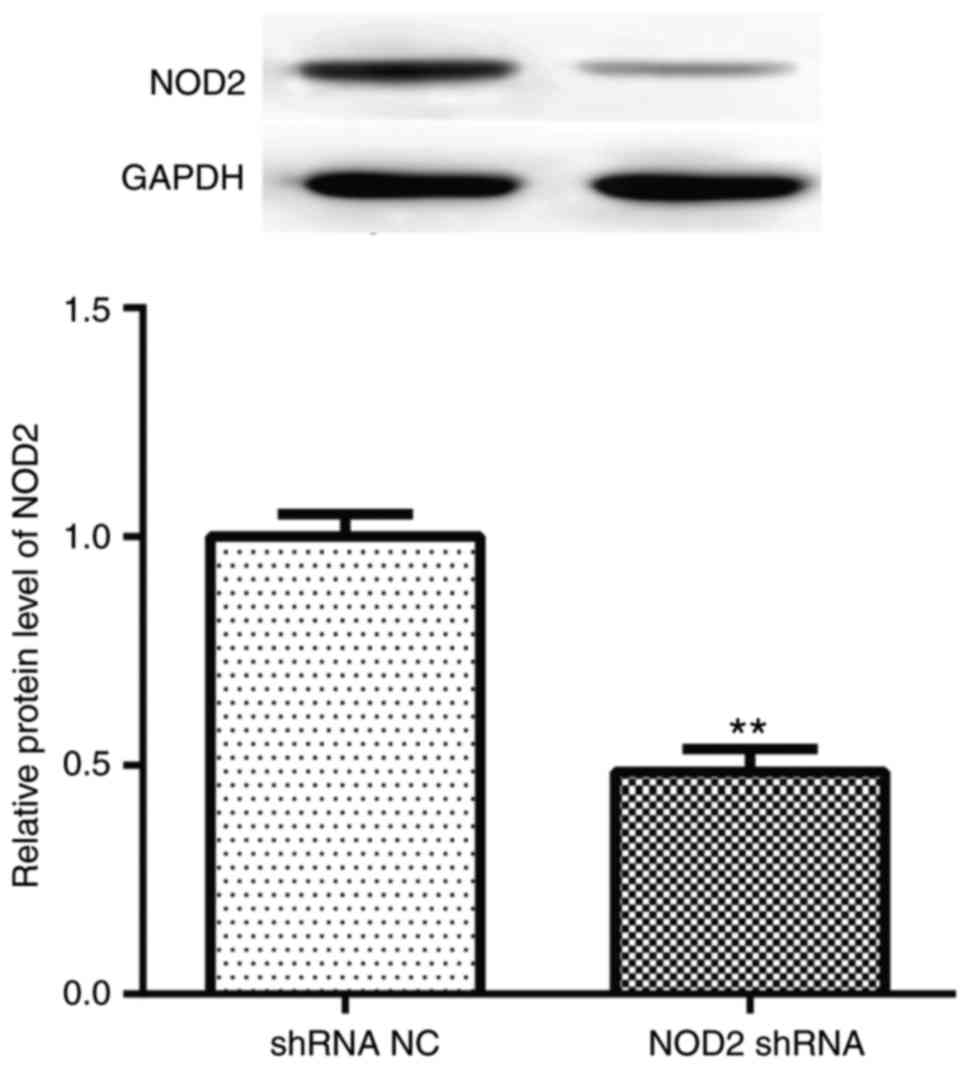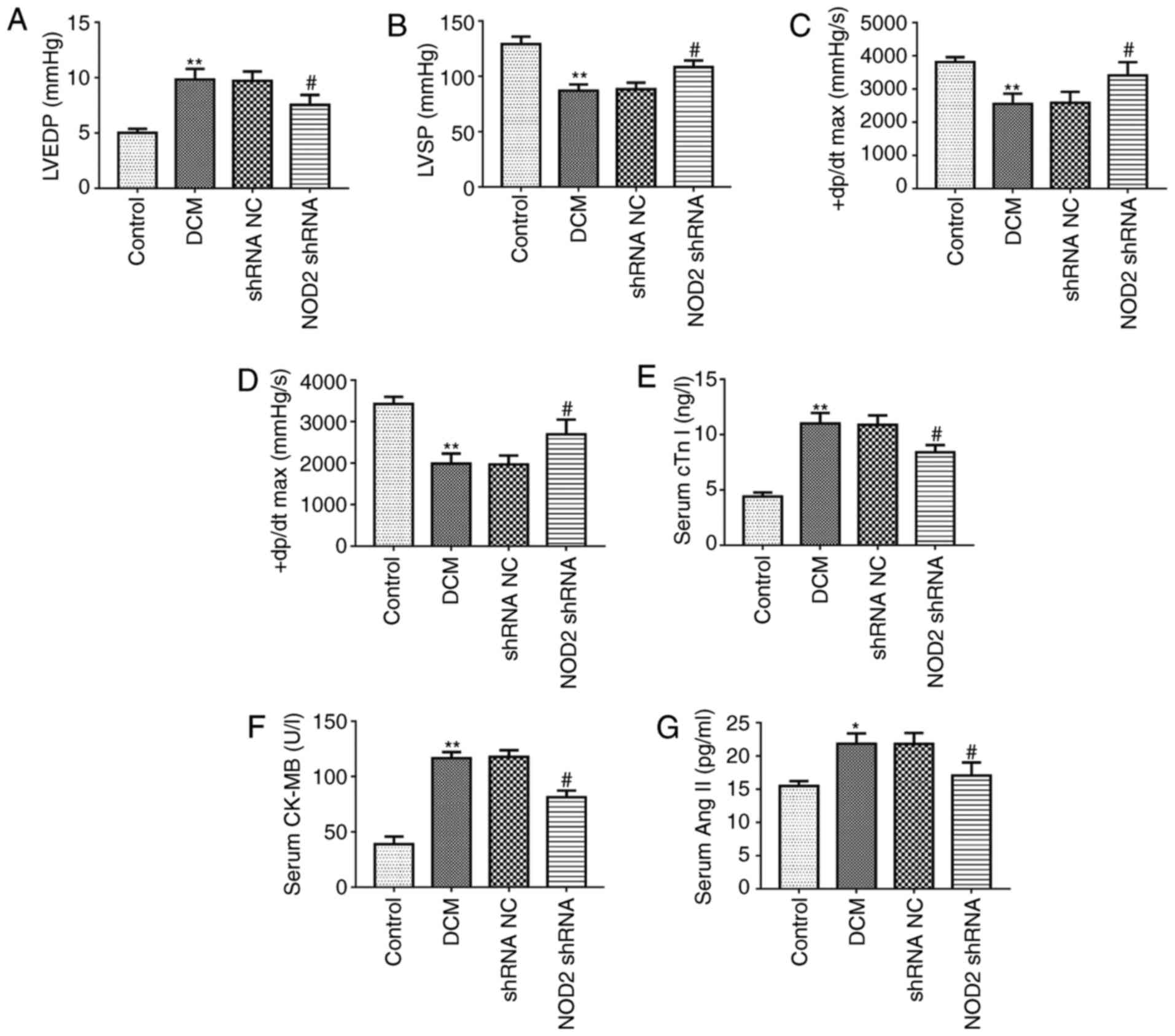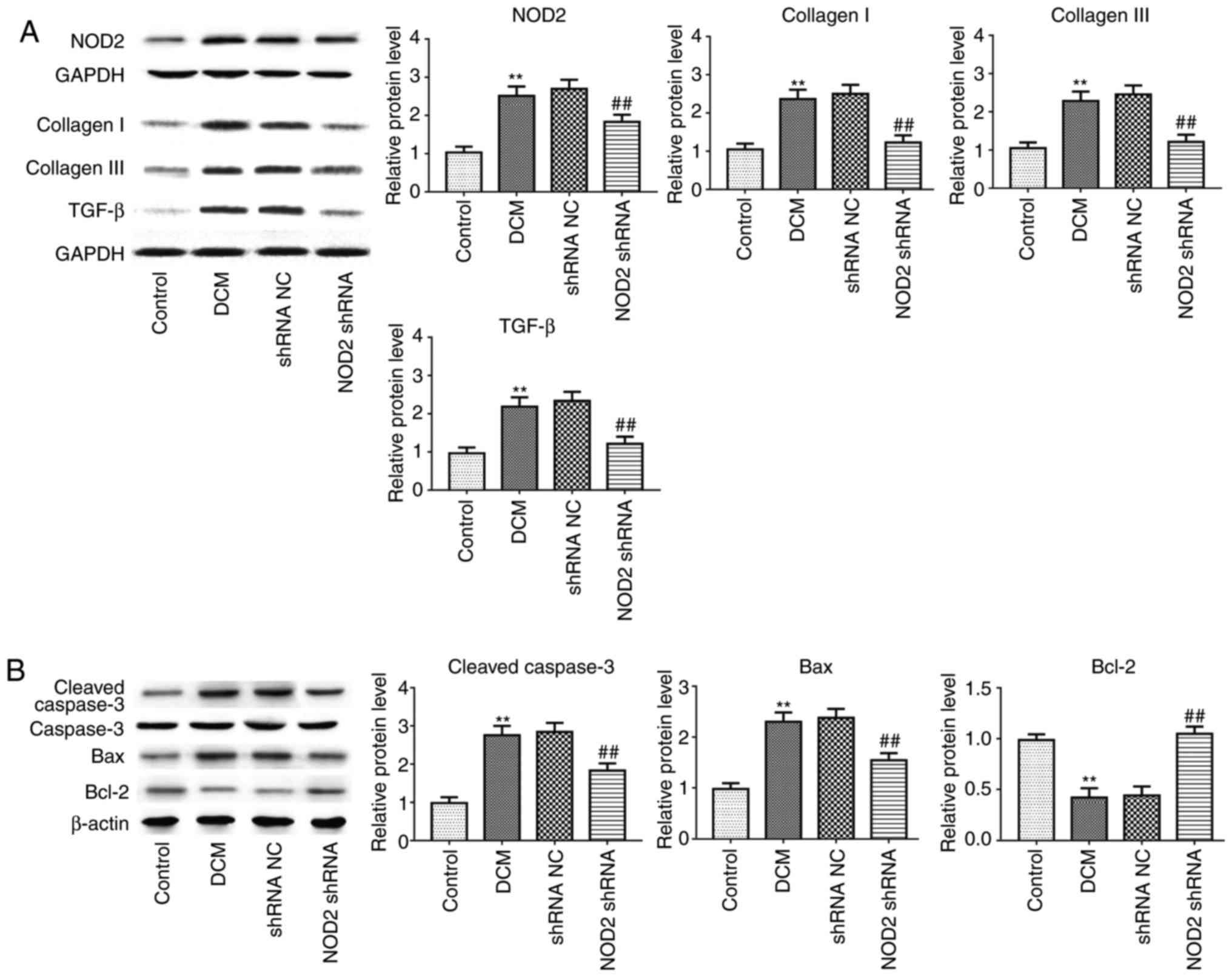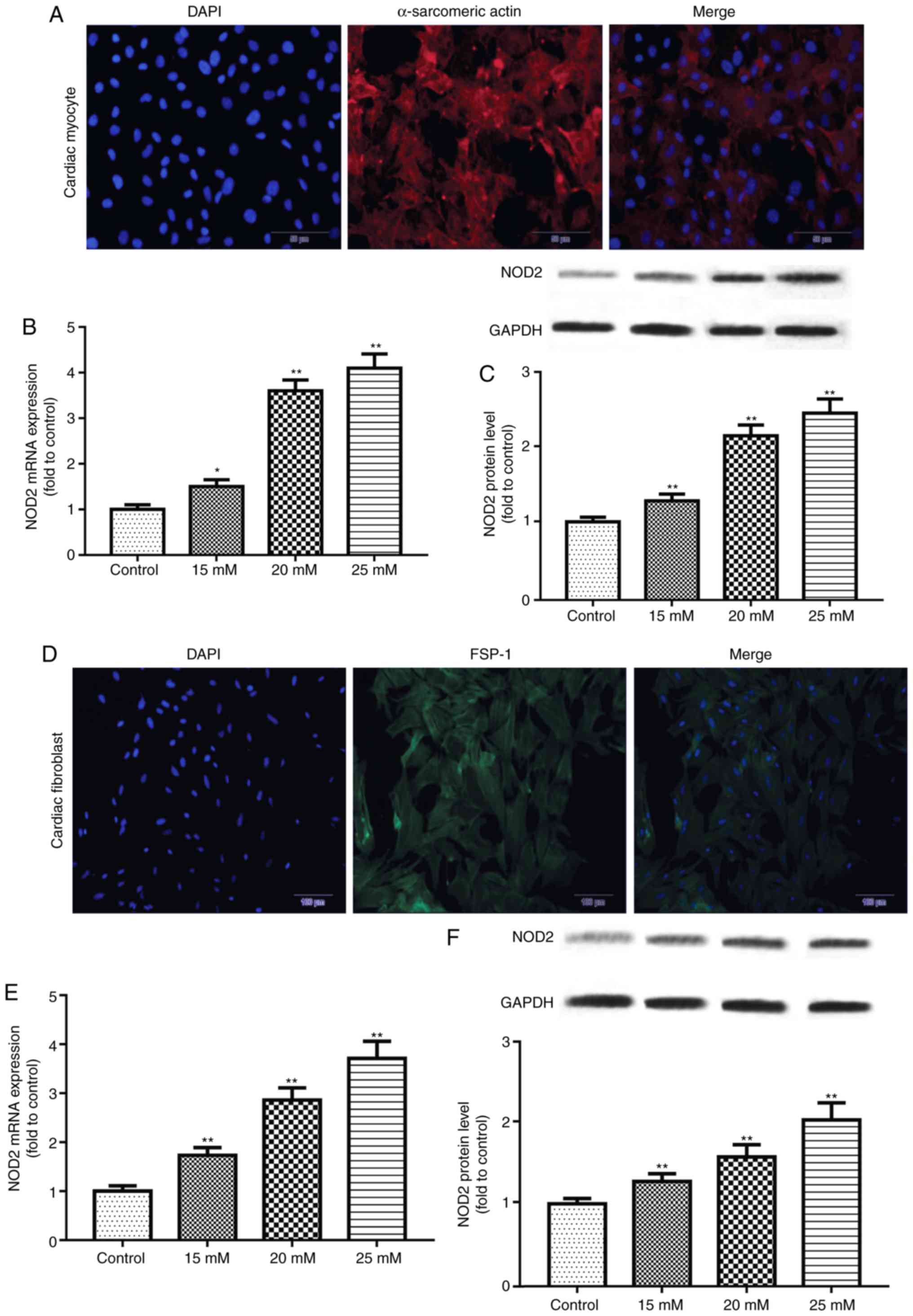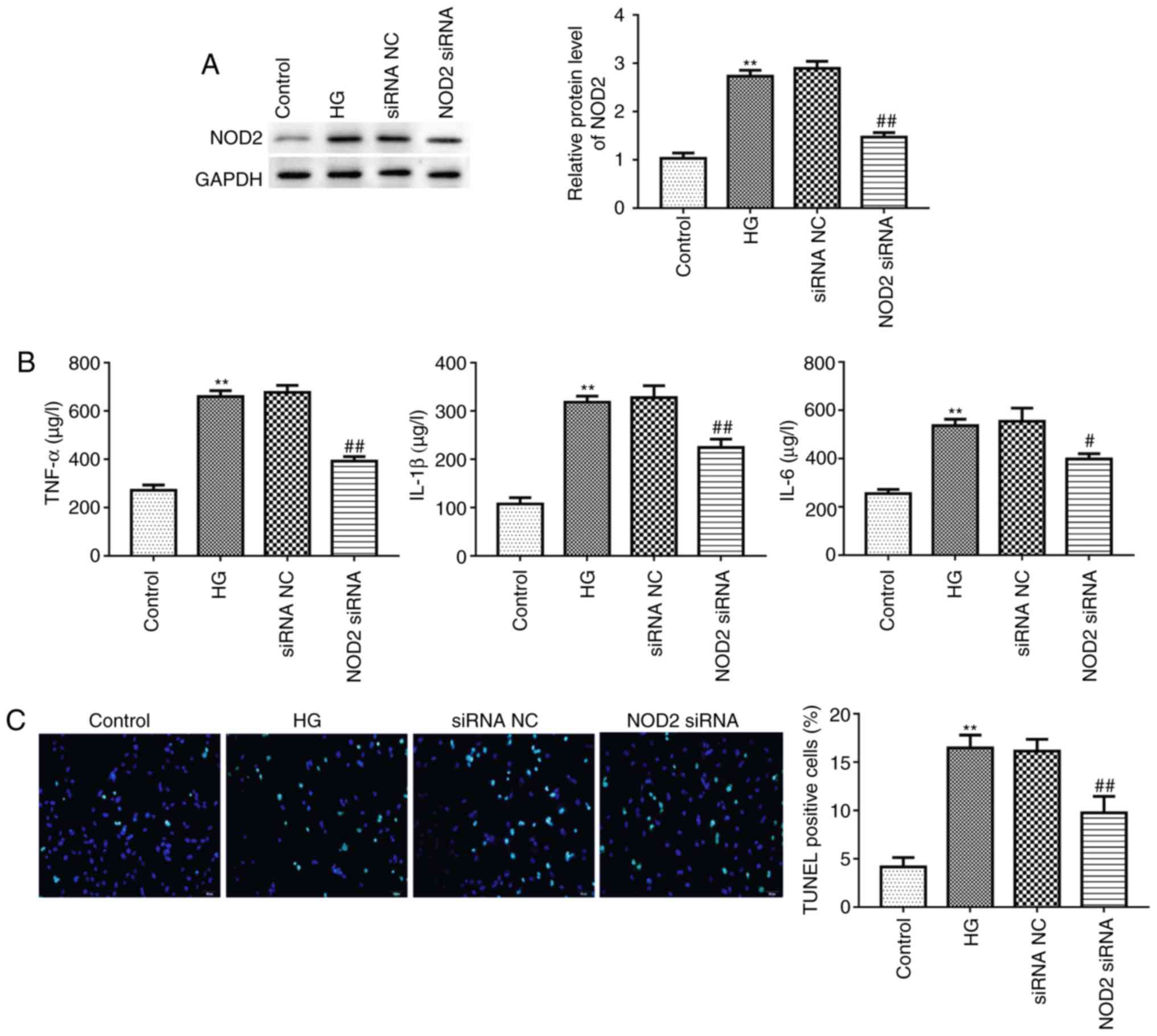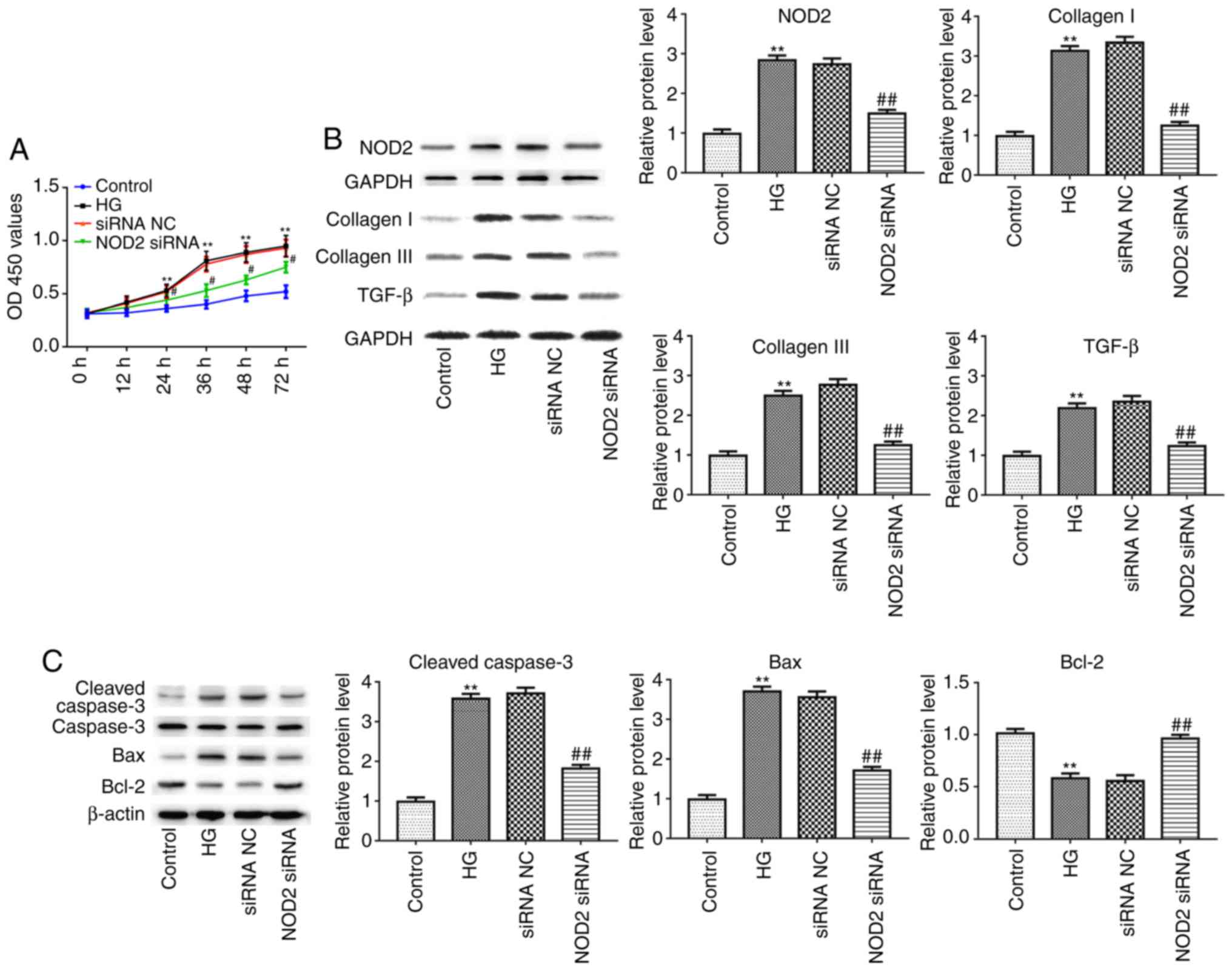|
1
|
Hillis GS, Woodward M, Rodgers A, Chow CK,
Li Q, Zoungas S, Patel A, Webster R, Batty GD, Ninomiya T, et al:
Resting heart rate and the risk of death and cardiovascular
complications in patients with type 2 diabetes mellitus.
Diabetologia. 55:1283–1290. 2012. View Article : Google Scholar : PubMed/NCBI
|
|
2
|
Adameova A and Dhalla NS: Role of
microangiopathy in diabetic cardiomyopathy. Heart Fail Rev.
19:25–33. 2014. View Article : Google Scholar
|
|
3
|
Bielecka-Dabrowa A, Wierzbicka M, Dabrowa
M and Goch A: New methods in laboratory diagnostics of dilated
cardiomy-opathy. Cardiol J. 15:388–395. 2008.
|
|
4
|
Carneiro LA, Magalhaes JG, Tattoli I,
Philpott DJ and Travassos LH: Nod-like proteins in inflammation and
disease. J Pathol. 214:136–148. 2008. View Article : Google Scholar
|
|
5
|
Zhang J, Li B, Zheng Z, Kang T, Zeng M,
Liu Y and Xia B: Protective effects of Notch1 signaling activation
against high glucose-induced myocardial cell injury: Analysis of
its mechanisms of action. Int J Mol Med. 36:897–903. 2015.
View Article : Google Scholar : PubMed/NCBI
|
|
6
|
DeMarco VG, Aroor AR and Sowers JR: The
pathophysiology of hypertension in patients with obesity. Nat Rev
Endocrinol. 10:364–376. 2014. View Article : Google Scholar : PubMed/NCBI
|
|
7
|
Lorenzo O, Picatoste B, Arescarrasco S,
Ramírez E, Egido J and Tuñón J: Potential role of nuclear factor κB
in diabetic cardiomy-opathy. Mediators Inflamm.
2011.652097:2011.
|
|
8
|
Zhang B, Qiang S, Chen Y, Pan R, Kuang S,
Liu G, Sun G and Sun X: Myricitrin alleviates oxidative
stress-induced inflammation and apoptosis and protects mice against
diabetic cardiomyopathy. Sci Rep. 7:442392017. View Article : Google Scholar : PubMed/NCBI
|
|
9
|
Mohammadshahi M, Haidari F and Soufi FG:
Chronic resveratrol administration improves diabetic cardiomyopathy
in part by reducing oxidative stress. Cardiol J. 21:39–46. 2014.
View Article : Google Scholar
|
|
10
|
Qin WD, Liu GL, Wang J, Wang H, Zhang JN,
Zhang F, Ma Y, Ji XY, Li C and Zhang MX: Poly(ADP-ribose)
polymerase 1 inhibition protects cardiomyocytes from inflammation
and apoptosis in diabetic cardiomyopathy. Oncotarget.
7:35618–35631. 2016. View Article : Google Scholar : PubMed/NCBI
|
|
11
|
Song JQ, Teng X, Cai Y, Tang CS and Qi YF:
Activation of Akt/GSK-3beta signaling pathway is involved in
inter-medin(153) protection against myocardial apoptosis induced by
ischemia/reperfusion. Apoptosis. 14:1299–1307. 2009. View Article : Google Scholar : PubMed/NCBI
|
|
12
|
Ares-Carrasco S, Picatoste B,
Benito-Martín A, Zubiri I, Sanz AB, Sánchez-Niño MD, Ortiz A, Egido
J, Tuñón J and Lorenzo O: Myocardial fibrosis and apoptosis, but
not inflammation, are present in long-term experimental diabetes.
Am J Physiol Heart Circ Physiol. 297:H2109–H2119. 2009. View Article : Google Scholar : PubMed/NCBI
|
|
13
|
Vadla GP and Vellaichamy E: Anti-fibrotic
cardio protective efficacy of aminoguanidine against streptozotocin
induced cardiac fibrosis and high glucose induced collagen up
regulation in cardiac fibroblasts. Chem Biol Interact. 197:119–128.
2012. View Article : Google Scholar : PubMed/NCBI
|
|
14
|
Wang HX, Zhang QF, Zeng XJ, Wang W, Tang
CS and Zhang LK: Effects of angiotensin III on protein, DNA, and
collagen synthesis of neonatal cardiomyocytes and cardiac
fibroblasts in vitro. J Cardiovasc Pharmacol Ther. 15:393–402.
2010. View Article : Google Scholar : PubMed/NCBI
|
|
15
|
Wang WK, Wang B, Lu QH, Zhang W, Qin WD,
Liu XJ, Liu XQ, An FS, Zhang Y and Zhang MX: Inhibition of
high-mobility group box 1 improves myocardial fibrosis and
dysfunction in diabetic cardiomyopathy. Int J Cardiol. 172:202–212.
2014. View Article : Google Scholar : PubMed/NCBI
|
|
16
|
Westermann D, Rutschow S, Jäger S,
Linderer A, Anker S, Riad A, Unger T, Schultheiss HP, Pauschinger M
and Tschöpe C: Contributions of inflammation and cardiac matrix
metalloproteinase activity to cardiac failure in diabetic
cardiomyopathy: The role of angiotensin type 1 receptor antagonism.
Diabetes. 56:641–646. 2007. View Article : Google Scholar : PubMed/NCBI
|
|
17
|
Correa RG, Milutinovic S and Reed JC:
Roles of NOD1 (NLRC1) and NOD2 (NLRC2) in innate immunity and
inflammatory diseases. Biosci Rep. 32:597–608. 2012. View Article : Google Scholar : PubMed/NCBI
|
|
18
|
Li CJ, Lv L, Li H and Yu DM: Cardiac
fibrosis and dysfunction in experimental diabetic cardiomyopathy
are ameliorated by alpha-lipoic acid. Cardiovasc Diabetol.
11:732012. View Article : Google Scholar : PubMed/NCBI
|
|
19
|
Geddes K, Magalhães JG and Girardin SE:
Unleashing the therapeutic potential of NOD-like receptors. Nat Rev
Drug Discov. 8:465–479. 2009. View
Article : Google Scholar : PubMed/NCBI
|
|
20
|
Liu Y, Yang H, Liu LX, Yan W, Guo HJ, Li
WJ, Tian C, Li HH and Wang HX: NOD2 contributes to myocardial
ischemia/reperfusion injury by regulating cardiomyocyte apoptosis
and inflammation. Life Sci. 149:10–17. 2016. View Article : Google Scholar : PubMed/NCBI
|
|
21
|
Perez-Chanona E, Mühlbauer M and Jobin C:
The microbiota protects against ischemia/reperfusion-induced
intestinal injury through nucleotide-binding oligomerization
domain-containing protein 2 (NOD2) signaling. Am J Pathol.
184:2965–2975. 2014. View Article : Google Scholar : PubMed/NCBI
|
|
22
|
Liu HQ, Zhang XY, Edfeldt K, Nijhuis MO,
Idborg H, Bäck M, Roy J, Hedin U, Jakobsson PJ, Laman JD, et al:
NOD2-mediated innate immune signaling regulates the eicosanoids in
atherosclerosis. Arterioscler Thromb Vasc Biol. 33:2193–2201. 2013.
View Article : Google Scholar : PubMed/NCBI
|
|
23
|
Fan Du, Han BP, Zhen H, Shang J, Wang J,
Li X, Shi X, Tang W, Bao WC, et al: NOD2 promotes renal injury by
exacerbating inflammation and podocyte insulin resistance in
diabetic nephropathy. Kidney Int. 84:265–276. 2013. View Article : Google Scholar : PubMed/NCBI
|
|
24
|
Livak KJ and Schmittgen TD: Analysis of
relative gene expression data using real-time quantitative PCR and
the 2(−Delta Delta C(T)) method. Methods. 25:402–408.
2001. View Article : Google Scholar
|
|
25
|
Vakhrusheva O, Smolka C, Gajawada P,
Kostin S, Boettger T, Kubin T, Braun T and Bober E: Sirt7 increases
stress resistance of cardiomyocytes and prevents apoptosis and
inflammatory cardiomyopathy in mice. Circ Res. 102:703–710. 2008.
View Article : Google Scholar : PubMed/NCBI
|
|
26
|
Falcão-Pires I and Leite-Moreira AF:
Diabetic cardiomyopathy: Understanding the molecular and cellular
basis to progress in diagnosis and treatment. Heart Fail Rev.
17:325–344. 2012. View Article : Google Scholar
|
|
27
|
Li Li, Chu FX, Wang Y, Zhang X, Hu H,
Zhang Y, Wang Y, Wei Z, Jian XW, et al: NOD2 deficiency protects
against cardiac remodeling after myocardial infarction in mice.
Cell Physiol Biochem. 32:1857–1866. 2013. View Article : Google Scholar : PubMed/NCBI
|
|
28
|
Zhao Y, Zhang L, Qiao Y, Zhou X, Wu G,
Wang L, Peng Y, Dong X, Huang H, Si L, et al: Heme oxygenase-1
prevents cardiac dysfunction in streptozotocin-diabetic mice by
reducing inflammation, oxidative stress, apoptosis and enhancing
autophagy. PLoS One. 8:e759272013. View Article : Google Scholar : PubMed/NCBI
|
|
29
|
Mano Y, Anzai T, Kaneko H, Nagatomo Y,
Nagai T, Anzai A, Maekawa Y, Takahashi T, Meguro T, Yoshikawa T and
Fukuda K: Overexpression of human C-reactive protein exacerbates
left ventricular remodeling in diabetic cardiomyopathy. Circ J.
75:1717–1727. 2011. View Article : Google Scholar : PubMed/NCBI
|
|
30
|
Liu ZW, Wang JK, Qiu C, Guan GC, Liu XH,
Li SJ and Deng ZR: Matrine pretreatment improves cardiac function
in rats with diabetic cardiomyopathy via suppressing ROS/TLR-4
signaling pathway. Acta Pharmacol Sin. 36:323–333. 2015. View Article : Google Scholar : PubMed/NCBI
|
|
31
|
Pan Y, Wang Y, Zhao Y, Peng K, Li W, Wang
Y, Zhang J, Zhou S, Liu Q, Li X, et al: Inhibition of JNK
phosphorylation by a novel curcumin analog prevents high
glucose-induced inflammation and apoptosis in cardiomyocytes and
the development of diabetic cardiomyopathy. Diabetes. 63:3497–3511.
2014. View Article : Google Scholar : PubMed/NCBI
|
|
32
|
Rubler S, Dlugash J, Yuceoglu YZ, Kumral
T, Branwood AW and Grishman A: New type of cardiomyopathy
associated with diabetic glomerulosclerosis. Am J Cardiol.
30:595–602. 1972. View Article : Google Scholar : PubMed/NCBI
|
|
33
|
Santos VN, Leite-Mór MM, Kondo M, Martins
JR, Nader H, Lanzoni VP and Parise ER: Serum laminin, type IV
collagen and hyaluronan as fibrosis markers in non-alcoholic fatty
liver disease. Braz J Med Biol Res. 38:747–753. 2005. View Article : Google Scholar : PubMed/NCBI
|
|
34
|
Miki T, Yuda S, Kouzu H and Miura T:
Diabetic cardiomyopathy: Pathophysiology and clinical features.
Heart Fail Rev. 18:149–166. 2013. View Article : Google Scholar :
|
|
35
|
Teshima Y, Takahashi N, Nishio S, Saito S,
Kondo H, Fukui A, Aoki K, Yufu K, Nakagawa M and Saikawa T:
Production of reactive oxygen species in the diabetic heart. Roles
of mitochondria and NADPH oxidase. Circ J. 78:300–306. 2014.
View Article : Google Scholar
|
|
36
|
Werner S, Krieg T and Smola H:
Keratinocyte-fibroblast interactions in wound healing. J Invest
Dermatol. 127:998–1008. 2007. View Article : Google Scholar : PubMed/NCBI
|
|
37
|
Zhang X, Ma X, Zhao M, Zhang B, Chi J, Liu
W, Chen W, Fu Y, Liu Y and Yin X: H2 and H3 relaxin inhibit high
glucose-induced apoptosis in neonatal rat ventricular myocytes.
Biochimie. 108:59–67. 2015. View Article : Google Scholar
|
|
38
|
Zhang YC, Mou YL and Xie YY: Research
progress in relations between renin angiotensin system and diabetic
cardiomyopathy. Sheng Li Ke Xue Jin Zhan. 42:269–275. 2011.In
Chinese. PubMed/NCBI
|















